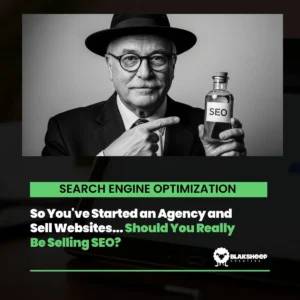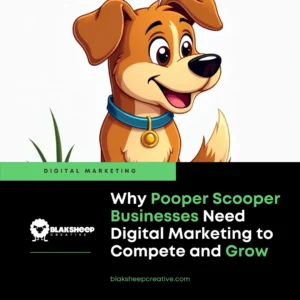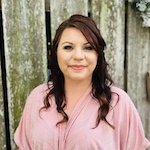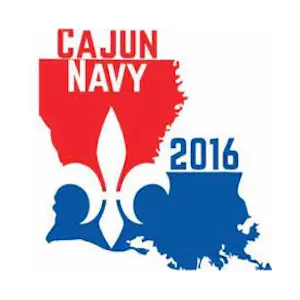We cringe when we hear these two words used interchangeably, especially by marketing “experts” here in Louisiana.
A marketing plan and a marketing strategy are two separate elements of your business’s marketing.
Your marketing strategy is your approach to achieving your competitive advantage — the marketing plan is the activities that will help you achieve your marketing goals.
Simply put, a marketing strategy is the “what,” and a marketing plan is the “how.”
Both a marketing plan and a marketing strategy are essential for your business’s growth, and this article will explain what each is, how they are alike, how they differ, and how the two work to help you meet your long-term marketing objectives.
What is a Marketing Strategy?
A marketing strategy is essentially a document that answers some of your company’s biggest questions:
- What you’re offering
- Who your target audience is
- What your company stands for
- Your brand’s guidelines
- What industry or niche you serve
- Who your main competitors are.
Of course, your marketing strategy can contain more or less information, but the purpose is to be a sort of compass and help you keep your company’s marketing focused on your marketing goals.
Your marketing strategy should be based on your overall business goals.
Suppose your business strategy is to grow your business revenue by 40%.
Then your marketing strategy will explain how marketing will help you achieve those goals.
It’s a 50,000-foot point of view.
Your marketing strategy should NOT go into laser-focused marketing tactics. That will come into play later on.
It should, however, attempt to answer the following questions:
8 Questions to Ask When Creating your Marketing Strategy

1. What business objectives does your marketing strategy need to support?
Believe it or not, this simple question tends to be overlooked.
Define your end game.
If your business hasn’t defined what you’re trying to sell, and to whom then your marketing strategy has a 0.00% chance of being successful.
Your marketing should move your business to a different place than where it currently is, such as:
- Gaining a larger market share
- Serving more customers
- Selling more products
- Expanding your services
- Increasing your market position
First, you want to clearly define your business objectives in measurable terms, for example:
- Increase revenue from $1M per year to $2M per year.
- Increase profit margin of 19%
- Sell 300k units of a new product
2. What statistics and metrics will we use to determine success or failure?
Before you type the first word on your marketing strategy, ask yourself (or your team) how you are going to determine if your marketing efforts have been successful.
Make sure that you have a means in place to measure and report on that data.
For example, if you define success as the number of conversions (new customers) from an email marketing campaign, you’ll need to have a CRM in place to know which new customers came from your email blast.
Invest in quality measurement tools so that you can effectively implement your marketing strategies.
3. What should my marketing budget be?
We get this question all the time. Marketers and business owners focus way too much on the perfect number and end up spending nothing at all.
Or, worse they spend based on a random figure, and no system is in place to have any meaningful impact.
The amount you should spend on your marketing is simply to spend what makes sense for your business.
How do you figure that out?
- Experts agree that 10-15% of your overall budget should be spent on planning and measurement tools.
- Be sure to include the costs of using your company’s internal resources (such as staff) for things like content marketing, segmenting lists, and addressing customer feedback, and budget accordingly.
- Simply figure out how much of your company’s profits you can invest in the business to support future growth. Don’t go out of business funding your marketing efforts.
4. What marketing strategies and plans have you used in the past?
Before you look ahead, it would do you well to look behind.
Look back at what you’ve already done to determine what’s worked in the past, and what hasn’t.
If you have access to performance data, now’s the perfect time to pull it out.
Learn from your mistakes, and try to duplicate your successes as best you can.
The more information you can analyze before you start making new decisions, the better informed you’ll be (and the smarter your decisions will be).
5. What’s your competitive landscape like?
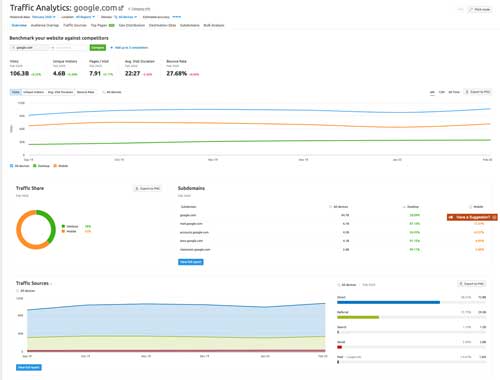
When building a new marketing strategy, it’s not just important to know what works and doesn’t work for your company. Take the time to analyze your competition as well.
Identify your competition, both locally and nationally (depending on your industry). It’s important to know how those that provide the same products or services are representing themselves.
Not only that, but you’re probably competing against businesses—and other factors—that might not occur to you without doing a little research.
Better said, you’re competing against more than just your competitors.
You are also competing against businesses that may not offer the exact same thing as you, but those whose offerings can have an impact on yours.
Throw in the digital marketplace, and now you’re competing with other businesses that may have the same name as yours.
So now that you know who your competition is, you’ll need to audit their marketing in the same manner that you did your own.
Take a look at what they’re doing, and compare it to what you’ve done.
To get a leg up on them, if you possibly can, take a look at their company’s website’s metrics by using a paid SEO tool such as Ahrefs or Semrush.
Now you can see what’s working for them, and what isn’t, just like you did for your own efforts.
6. What messages will work for your audience, and how will you position them?
Before you start banging out content, you need to establish who you’ll be talking to and how you should talk to them.
Don’t take a shot in the dark, and don’t make assumptions. Actually do the research to identify your audience and to determine what messages and positioning will be the best suited for them.
You can easily do this by examining data you should already be collecting from your website via analytics tools such as Google Search Console (Webmaster Tools) and Google Analytics.
If your company doesn’t have a website, check out our pay-per-month website program to help avoid resource-draining website development costs.
- Who’s searching for you
- Who’s visiting your website
- What their behavior is on your website
Build customer personas based on that and any other market research you have access to or have done yourself.
Now that you have that information, it should be evident what your message should be, and who it should be said to.
Bear in mind, that it is critical that your content
- Matches your branding strategy
- Matches your organization’s voice and persona
- Is authentic to who your brand
7. Who can assist in implementation?
Take an inventory of those people inside and outside your organization who can assist with carrying out your plan.
Allow these people to guide your strategic marketing plan.
A strategy is of no use if you lack the financial or human capital to execute it.
Get creative.
In addition to company staff, think about bringing in the expertise of industry leaders, key partners, influencers, vendors, clients, and interns.
How can you use all of these individual contributions to support mutual goals?
42 percent of companies have a designated content strategist. Consider hiring one for your business.
The main reason that great ideas and strategies are unexecuted is that no one took the time to figure out who was going to do the work.
8. Who is going to be in charge?
While momentum is important in marketing, so is consistent execution.
Without a clear decision-making process prior to content creation, your ideas and work may get lost in unresponsiveness or opinions.
Assign one trustworthy person the responsibility of approving all content.
The more complex your process is the smaller your chances of having a strategic marketing effort.
Too many chefs spoil the stew.
What is a Marketing Plan?
Your marketing plan is based on your marketing strategy, and consists of the specifics and methods you will be using to achieve your goals:
- What channels and tactics you’ll use
- Which portions of your target market will you focus on
- How will you be measuring success
As opposed to your marketing strategy, your marketing plan is more concerned with which tactics, campaigns, initiatives, and promotions you’ll run in a designated amount of time.
When you create a marketing plan, bear in mind that typical marketing plans can range from three months to a year and should remain semi-flexible in the event that your marketing needs to shift priorities.
Marketing Strategy vs. Marketing Plan
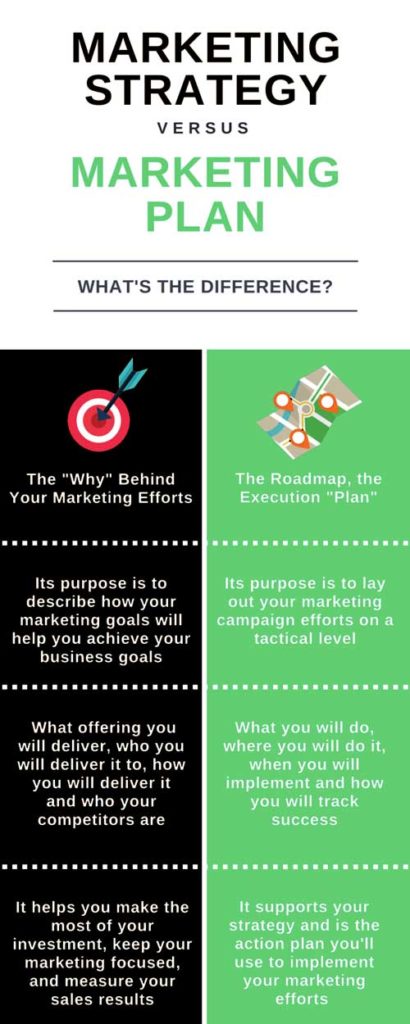
To help you visualize all of this, we’ve created a graphic that explains some of the core differences between a marketing strategy and a marketing plan.
In our experience, your marketing strategy probably won’t change as much as your marketing plan.
If it does, it’s almost impossible to gain any real traction or to effectively measure the impact of your marketing on the business.
However, you’ll probably need to revisit your marketing strategy each year, whereas you’ll be executing against your marketing plan regularly.
Example: Content Marketing
Most marketers have some knowledge of content marketing, so we’ll it as an example.
Like mentioned earlier, strategies address high-level issues whereas plans show how you’re going to execute.
Content Marketing Strategy
Your content marketing strategy plan should include some basic questions:
- Who will we be writing to?
- How will our content marketing support our business goals?
- How much money can we spend on content creation?
- Who are our competitors?
- What tone do we want our content to take?
Your content marketing strategy isn’t intended to point out every single topic you’re going to write about or even what your specific KPIs for the upcoming year are going to be.
Instead, it’s supposed to give you some context as to why you’re investing in content marketing, who you’re targeting, what mediums (website, social media, print ads) you’re going to use, and more.
Content Marketing Plan
Now that you have your content marketing strategy set, your content marketing plan will explain how you’re going to attack the problem.
Here is where you will document your goals and KPIs, the resources you intend on creating, when you will be creating them, who will be creating them, how you’ll be promoting each piece of content, and more.
At the least, you should set up an editorial calendar to make everyone aware of what topics your content is addressing, where it’s being published, when it’s being published, what channels it’ll be promoted through, and what goals it should be aiming to hit.
Conclusion
We realize that this may seem like a lot cause it is. The important thing to remember is that effective marketing requires planning, execution, and analytics.
As always, if you need help creating an effective marketing plan, analyzing your marketing strategy, or anything else in our wheelhouse, feel free to contact us, and we’ll give you a free consultation.

